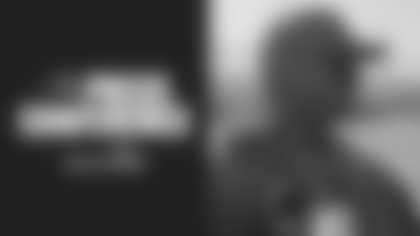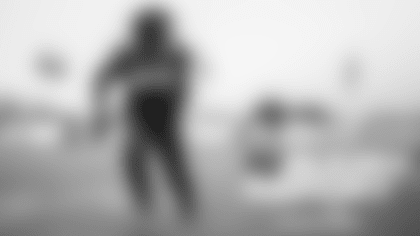The Bucs got Nebraska LB Barrett Ruud early in the second round last year, but won't be picking anywhere near that high in 2006
The Houston Texans will pick first in the 2006 NFL Draft. Nineteen other teams wish they were higher. The remaining twelve teams hope they drop to last.
The Tampa Bay Buccaneers are among that final dozen because they made the playoffs along with 11 other teams. No matter where those 12 teams are currently ranked in the draft order, the one that wins Super Bowl XXXIX will be put into the 32nd and final slot.
At this point, with the playoffs still promising to shake up the final 12 picks a bit, the Bucs are scheduled to pick 24th, a drop of 19 spots from last year that reflects the team's rebound from 5-11 in 2004 to 11-5 in 2005.
The NFL's draft order is determined by teams' records from the previous year, worst to best. Within each group of teams tied with the same record, the order is determined by the teams' strength of schedule the previous season; that is, the combined winning percentage of all of its opponents. The better a team's strength of schedule – presumably meaning that it created its record against tougher opponents and is therefore a better team – the worse its draft spot.
In a season that was very top and bottom-heavy, the Bucs were one of six teams to finish 11-5, along with the Carolina Panthers, the Chicago Bears, the Cincinnati Bengals, the New York Giants and the Pittsburgh Steelers. Of those six teams, the Bucs and Panthers were tied for the lowest strength of schedule percentage at .449. That currently has Carolina slotted 23rd and the Bucs' 24th, followed by Chicago (.457), Cincinnati (.477), New York (.492) and Pittsburgh (.492).
Here is the complete 2006 draft order, as it stands now:
| **Position** | **Team** | **Record** | **Strength of Sched.** |
| 1 | Houston Texans | 2-14 | .535 |
| 2 | New Orleans Saints | 3-13 | .523 |
| 3 | Tennessee Titans | 4-12 | .512 |
| 4 | New York Jets | 4-12 | .527 |
| 5 | Green Bay Packers | 4-12 | .531 |
| 6 | Oakland Raiders | 4-12 | .539 |
| 6 | San Francisco 49ers | 4-12 | .539 |
| 8 | Buffalo Bills | 5-11 | .500 |
| 9 | Detroit Lions | 5-11 | .504 |
| 10 | Arizona Cardinals | 5-11 | .508 |
| 11 | St. Louis Rams | 6-10 | .484 |
| 12 | Cleveland Browns | 6-10 | .508 |
| 13 | Baltimore Ravens | 6-10 | .523 |
| 14 | Philadelphia Eagles | 6-10 | .531 |
| 15 | Atlanta Falcons | 8-8 | .492 |
| 16 | Miami Dolphins | 9-7 | .457 |
| 17 | Minnesota Vikings | 9-7 | .484 |
| 18 | Dallas Cowboys | 9-7 | .523 |
| 19 | San Diego Chargers | 9-7 | .559 |
| 20 | Kansas City Chiefs | 10-6 | .504 |
| 21 | New England Patriots | 10-6 | .508 |
| 22 | Washington Redskin | 10-6 | .539 |
| 23 | Carolina Panthers | 11-5 | .449 |
| 24 | Tampa Bay Buccaneers | 11-5 | .449 |
| 25 | Chicago Bears | 11-5 | .457 |
| 26 | Cincinnati Bengals | 11-5 | .477 |
| 27 | New York Giants | 11-5 | .492 |
| 28 | Pittsburgh Steelers | 11-5 | .492 |
| 29 | Jacksonville Jaguars | 12-4 | .465 |
| 30 | Seattle Seahawks | 13-3 | .430 |
| 31 | Denver Broncos | 13-3 | .500 |
| 32 | Indianapolis Colts | 14-2 | .457 |
Those first 20 spots are locked in, with the exception of the sixth and seventh places, which will be decided at some point with a coin flip. The winner of the flip between Oakland and San Francisco, two teams that finished 4-12 and had identical .539 opponent winning percentages will pick sixth, the loser seventh.
The last 12 spots, as we mentioned, are subject to change depending upon how far each team advances in the playoffs. However, a team cannot drop out of its segment of tied teams unless it advances all the way to the big game at the end. The loser of Super Bowl XXXIX will pick 31st, the winner 32nd.
Thus, if the Bucs' do not make it to the Super Bowl, the worst they could pick would be 28th. That would occur if the Bucs advanced the furthest of the six teams tied at 11-5. For instance, if the Bucs won in the opening round and the Giants lost, then the Bucs (and the Panthers, who would have beaten the Giants) would slide behind New York in the draft order. However, even if the 12-4 Jacksonville Jaguars also lose that first weekend, the victorious Bucs could not slide down past the Jags' 29th spot unless they went all the way to the Super Bowl.
That also means that the highest the Bucs will draft is 23rd. That would occur if Tampa Bay loses and Carolina wins this weekend. If the Bucs and Panthers advance (or fail to advance) to the same place in the playoffs, then the two teams will have to have their own coin flip to see which will go first in the draft.
It is important to note that the above draft order is only completely accurate in reference to the first round. As the draft progresses, the teams within tied segments rotate spots from round to round. The rotation occurs upward; that is, the team at the top of the tied segment drops down a spot, and so on, and the team at the bottom slides back to the top.
For instance, the three 5-11 teams – Buffalo, Detroit and Arizona – are slated to pick eight, ninth and 10th in the 2006 draft, with that order determined by their relative strength of schedule numbers. In Round Two, Buffalo will drop to ninth, Detroit to 10th, and Arizona will slide back around to eighth. And so on.
That means a lot of bobbing up and down the order for the Buccaneers unless they reach the Super Bowl. With six teams in their tied segment, as it currently stands the Bucs wouldn't pick again in the same spot as their first round until the seventh and final round.
However it shakes out, the Bucs will draft later than they have since 2003 when, of course, they were slotted last after winning Super Bowl XXXVII. Tampa Bay also picked 27th in 2000 after an 11-5 season in 1999, but the 24th spot would be the third-lowest draft place in franchise history.
The 24th pick in last year's draft was California quarterback Aaron Rodgers, who went to the Green Bay Packers. In 2004, it was Oregon State running back Steven Jackson, to St. Louis, and in 2003 it was Iowa tight end Dallas Clark, to Indianapolis.
The 2006 NFL Draft will be held on the weekend of April 29-30.
























